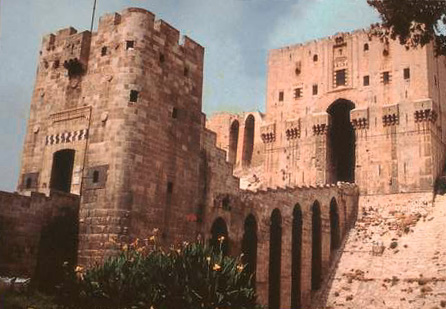
360 Km. north of Damascus. Fabled city of a long history of glory and prosperity since the 3rd millenium BC.
Said to be among the oldest continuously populated cities in the world.
Aleppo has been an important trading center between the countries of Asia and Mediterranean Europe since Roman times, and this history of continued contact with merchants gives the city both a charming oriental and a familiar European feel. It has played a vital role in the history of the area from the time of the Akkadian and Amorite Kingdoms until recently since it was situated at the junction of the ancient trade routes. Various architectural styles decorate the city and you can find everything from thirteenth century caravan serais and Hammams to nineteenth century Baroque buildings and Chinese pagodas. It is a city which, perhaps even more than Damascus, readily leads you back into the past, a sort of time continuum in which flashes of the past, accumulate in the present. It is still an animated Arab Bazaar city where the traditions of the Arab Middle Ages don’t seem all that remote. It still (perhaps more than any other city of the Levant) works according to the conventions of commercial life unbroken since ancient times. The most impressive sight for visitors is the colossal citadel of Aleppo, which dominates the entire city.

Aleppo’s main attraction is the fascinating area of covered souks, a maze of narrow, twisting streets, reaching 7 Km. long, under a vaulted, stone roof, selling jewelry, spices, silk and variety of other treasures.
Aleppo has an important archeological museum. The church of St. Simon, the largest church in the Middle East when it was built in the fifth century, is also nearby.

Because the city of Aleppo is such a melting pot of nationalities and cultures, there is a fine selection of local dishes in the restaurants of the city.
It is also the land of oriental music and from it the famous Qudood emerged.
The region of Aleppo attracts visitors who are interested in arts and archeology. It is known for its forgotten (deserted) cities where there are more than six hundred archeological sites: Grand tombs, churches, monasteries, beautiful country houses, stony villages spread all over the area and form a fascinating scene like: Serjila, Qalb Lozeh, Al Bara.
About Syria | Travelers Map of Syria | About Maan | Sample Trips | Email Maan
Maan Al-Sabbagh
Tour Guide-Trip Leader
Mobile phone:(00963)(0)93 252233
Telephone/Fax: (00963)-11-6714252
Email: maan@reuteronline.net
![]()
![]()